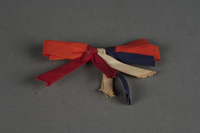Overview
- Brief Narrative
- Napkin ring, one of ten woven "trinkets" made at Liebenau by Pieterdina and her daughters Katherine and Henrietta: box, 2 napkin rings, 2 round pins, 1 bar pin, 2 hat pins, 1 hat and 1 cluster of flowers. Pieterdina and her children moved from Oregon back to the Netherlands after her husband passed away. Although the family was not Jewish, Pieterdina and her daughters were incarcerated as American citizens in Liebenau. In 1944, they were part of a prisoner exchange for German POWs and the family returned to the United States on March 15, 1944.
- Date
-
inclusive:
1942-1944
- Geography
-
creation:
Liebenau (Concentration camp);
Meckenbeuren (Germany)
- Credit Line
- United States Holocaust Memorial Museum Collection, Gift of Anna Margaret Binder
- Contributor
-
Creator:
Sietsema family
- Biography
-
Pieterdina Sietsema (née Dyksterhuis or Dijksterhuis, 1878-1962) was born on 26 February 1878 in Noordwolde, Netherlands (near Groningen). Her father was Menko Dyksterhuis and she had two sisters and three brothers. She grew up in a Christian family on a large farm. She married Niklaas Hendrik Sietsema (1873-1929), a veteran of the Boer War, around 1906. The couple emigrated from the Netherlands to the United States and settled in Nyssa, Oregon where they had two daughters: Katherine (1911-1992, later Katherine Kamps) and Henrietta (1913-1983). The family moved to Amsterdam, Idaho around 1913 to operate a farm, and their son Gerrit (1915-1991) was born there in 1915. Her husband had asthma and died in February 1929. Facing financial hardships, Pieterdina and her children returned to the Netherlands in November 1929, and settled in Groningen. Katherine and Henrietta studied nursing, and Gerrit studied horticulture.
In April 1938 Gerrit moved back to the United States and settled in Ripon, CA where he worked as a gardener. He was drafted and served with the United States Army in North Africa and Italy. After the war, he settled in Alameda, CA and worked at the Naval Air Station. He married Hilda Zomer in 1951. Hilda was a nurse and survived the war in the Netherlands.
Germany invaded the Netherlands in May 1940, and by 14 February 1942 Pieterdina, Katherine, and Henrietta were all imprisoned in Internment Camp V Liebenau. The camp housed civilians from foreign nations. They were released in March 1944 as part of a prisoner exchange, and returned to the United States aboard the MS Gripsholm. They eventually joined Gerrit in California. Katherine married John Kamps in 1961.
Physical Details
- Classification
-
Household Utensils
- Category
-
Tableware
- Object Type
-
Napkin rings (lcsh)
- Physical Description
- Woven napkin ring made at Liebenau by Pieterdina and her daughter Katherine and Henrietta.
- Dimensions
- overall: Height: 0.787 inches (1.999 cm) | Width: 2.362 inches (5.999 cm) | Diameter: 0.689 inches (1.75 cm)
- Materials
- overall : cloth, natural fiber
Rights & Restrictions
- Conditions on Access
- No restrictions on access
- Conditions on Use
- No restrictions on use
Keywords & Subjects
- Geographic Name
- Meckenbeuren (Germany)
- Personal Name
- Sietsema, Pieterdina. Sietsema, Katherine. Sietsema, Henrietta.
- Corporate Name
- Liebenau (Concentration camp)
Administrative Notes
- Legal Status
- Permanent Collection
- Provenance
- The napkin ring was donated to the United States Holocaust Memorial Museum in 2019 by Anna Margaret Binder, the paternal granddaughter of Pieterdina Sietsema.
- Record last modified:
- 2024-03-29 11:44:31
- This page:
- https://collections.ushmm.org/search/catalog/irn714044
Download & Licensing
In-Person Research
- By Appointment
- Request 21 Days in Advance of Visit
- Plan a Research Visit
- Request to See This Object
Contact Us
Also in Sietsema and Zomer families collection
The collection documents the wartime experiences of the Sietsema and Zomer families, originally from the Netherlands. Documents consist of two letters regarding the imprisonment of Pieterdina Sietsema and her daughters Katherine and Henrietta, all three American citizens, in Liebenau internment camp from 1942-1944. Objects consist of patriotic ribbon worn by Hilda Zomer after the Netherlands was liberated, and ten woven "trinkets" made at Liebenau by Pieterdina and her daughters Katherine and Henrietta: box, 2 napkin rings, 2 round pins, 1 bar pin, 2 hat pins, 1 hat, and 1 cluster of flowers.
Date: 1942-1944
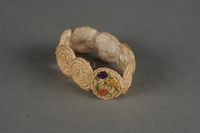
Woven napkin ring
Object
Napkin ring, one of ten woven "trinkets" made at Liebenau by Pieterdina and her daughters Katherine and Henrietta: box, 2 napkin rings, 2 round pins, 1 bar pin, 2 hat pins, 1 hat and 1 cluster of flowers. Pieterdina and her children moved from Oregon back to the Netherlands after her husband passed away. Although the family was not Jewish, Pieterdina and her daughters were incarcerated as American citizens in Liebenau. In 1944, they were part of a prisoner exchange for German POWs and the family returned to the United States on March 15, 1944.
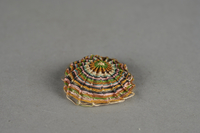
Woven pin
Object
Round woven pin, one of ten woven "trinkets" made at Liebenau by Pieterdina and her daughters Katherine and Henrietta: box, 2 napkin rings, 2 round pins, 1 bar pin, 2 hat pins, 1 hat and 1 cluster of flowers. Pieterdina and her children moved from Oregon back to the Netherlands after her husband passed away. Although the family was not Jewish, Pieterdina and her daughters were incarcerated as American citizens in Liebenau. In 1944, they were part of a prisoner exchange for German POWs and the family returned to the United States on March 15, 1944.
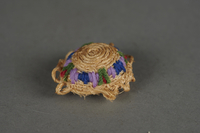
Woven hat pin
Object
Hatpin, one of ten woven "trinkets" made at Liebenau by Pieterdina and her daughters Katherine and Henrietta: box, 2 napkin rings, 2 round pins, 1 bar pin, 2 hat pins, 1 hat and 1 cluster of flowers. Pieterdina and her children moved from Oregon back to the Netherlands after her husband passed away. Although the family was not Jewish, Pieterdina and her daughters were incarcerated as American citizens in Liebenau. In 1944, they were part of a prisoner exchange for German POWs and the family returned to the United States on March 15, 1944.
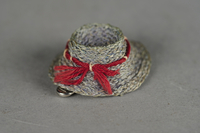
Woven hatpin
Object
Hatpin, one of ten woven "trinkets" made at Liebenau by Pieterdina and her daughters Katherine and Henrietta: box, 2 napkin rings, 2 round pins, 1 bar pin, 2 hat pins, 1 hat and 1 cluster of flowers. Pieterdina and her children moved from Oregon back to the Netherlands after her husband passed away. Although the family was not Jewish, Pieterdina and her daughters were incarcerated as American citizens in Liebenau. In 1944, they were part of a prisoner exchange for German POWs and the family returned to the United States on March 15, 1944.
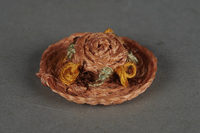
Woven miniature hat
Object
Woven miniature hat, one of ten woven "trinkets" made at Liebenau by Pieterdina and her daughters Katherine and Henrietta: box, 2 napkin rings, 2 round pins, 1 bar pin, 2 hat pins, 1 hat and 1 cluster of flowers. Pieterdina and her children moved from Oregon back to the Netherlands after her husband passed away. Although the family was not Jewish, Pieterdina and her daughters were incarcerated as American citizens in Liebenau. In 1944, they were part of a prisoner exchange for German POWs and the family returned to the United States on March 15, 1944.
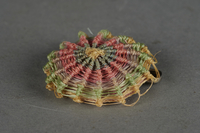
Woven pin
Object
Pin, one of ten woven "trinkets" made at Liebenau by Pieterdina and her daughters Katherine and Henrietta: box, 2 napkin rings, 2 round pins, 1 bar pin, 2 hat pins, 1 hat and 1 cluster of flowers. Pieterdina and her children moved from Oregon back to the Netherlands after her husband passed away. Although the family was not Jewish, Pieterdina and her daughters were incarcerated as American citizens in Liebenau. In 1944, they were part of a prisoner exchange for German POWs and the family returned to the United States on March 15, 1944.
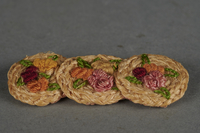
Woven bar pin
Object
Pin, one of ten woven "trinkets" made at Liebenau by Pieterdina and her daughters Katherine and Henrietta: box, 2 napkin rings, 2 round pins, 1 bar pin, 2 hat pins, 1 hat and 1 cluster of flowers. Pieterdina and her children moved from Oregon back to the Netherlands after her husband passed away. Although the family was not Jewish, Pieterdina and her daughters were incarcerated as American citizens in Liebenau. In 1944, they were part of a prisoner exchange for German POWs and the family returned to the United States on March 15, 1944.

Cluster of flowers
Object
Cluster of flowers made of natural fibers, yarn and metal, one of ten "trinkets" made at Liebenau by Pieterdina and her daughters Katherine and Henrietta: box, 2 napkin rings, 2 round pins, 1 bar pin, 2 hat pins, 1 hat and 1 cluster of flowers. Pieterdina and her children moved from Oregon back to the Netherlands after her husband passed away. Although the family was not Jewish, Pieterdina and her daughters were incarcerated as American citizens in Liebenau. In 1944, they were part of a prisoner exchange for German POWs and the family returned to the United States on March 15, 1944.
Sietsema family papers
Document
The collection consists of two letters regarding the imprisonment of Pieterdina Sietsema and her daughters Katherine and Henrietta, all three American citizens, in Liebenau internment camp from 1942-1944. The first is a personal letter sent from Liebenau from Katherine to her brother Gerrit in California on 8 July 1943. The second letter was sent to Pieterdina from the United States Department of State regarding promissory notes issued to cover repatriation costs for her and her daughters to return to the United States aboard the MS Gripsolm on 7 March 1944.
Woven box with cloth lining
Object
Woven box with cloth lining, one of ten woven "trinkets" made at Liebenau by Pieterdina and her daughters Katherine and Henrietta: box, 2 napkin rings, 2 round pins, 1 bar pin, 2 hat pins, 1 hat and 1 cluster of flowers. Pieterdina and her children moved from Oregon back to the Netherlands after her husband passed away. Although the family was not Jewish, Pieterdina and her daughters were incarcerated as American citizens in Liebenau. In 1944, they were part of a prisoner exchange for German POWs and the family returned to the United States on March 15, 1944.

